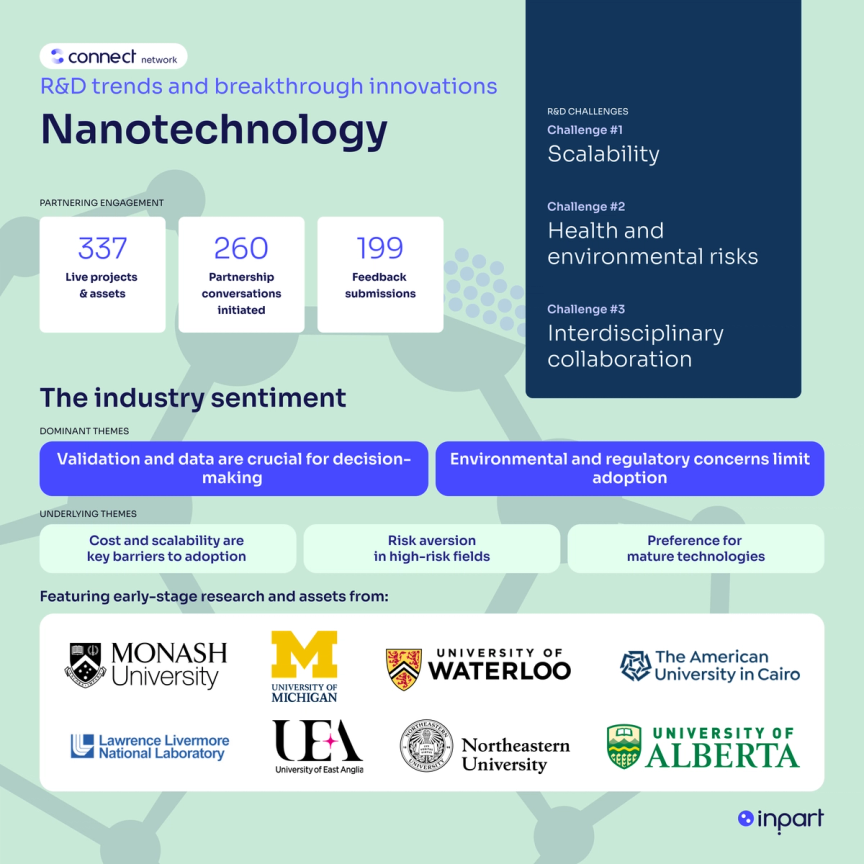Nanotechnology R&D trends and breakthrough innovations
This report aims to provide scientific decision-makers with R&D trends and the most-promising, high-impact research and assets in nanotechnology.
The trends and breakthroughs featuring in this report are surfaced from analyzing the engagement of industry of R&D, S&E, and external innovation teams using our online partnering platform, Connect, to identify their next scientific partners.
Through this data-driven approach, which offers a roadmap of high-impact opportunities in an evolving and competitive landscape, scientific decision-makers can pinpoint emerging technologies and identify potential partners to accelerate the cross-sector deployment of nanotechnologies.

Download the report

Key R&D challenges for nanotechnology
Manipulating materials at the nanoscale (between 1 and 100 nanometers) continues to revolutionize industries by enabling the creation of systems with unique properties and applications. For context, a sheet of paper is about 100,000 nanometers thick. By working at the nanoscale, scientists can unlock previously unreachable innovation. Using nanotechnology, materials can be made stronger, lighter, more durable, reactive, and targeted, with applications across most industries including healthcare, electronics, energy, and environmental sustainability.
The value of nanotechnology in R&D is demonstrated through government-led initiatives in the USA, Europe, Japan and China. The USA’s National Nanotechnology Initiative, for example, had a budget in 2023 of $1.99-billion. By focusing R&D on leveraging nanoscale properties and behavior, companies can gain competitive advantages, create more efficient processes, and develop products with superior functionality. The capacity of nanotechnology to solve complex challenges at an atomic scale positions it as a key driver for innovation and a strategic focus for sustainable growth and technological progress.
Challenge #1
Scalability
Scalability is a significant challenge in nanotechnology R&D due to the difficulty in translating the unique behaviors materials exhibit at the nanoscale to larger scales. Techniques including nanofabrication, nanocoating, and synthesis to create nanomaterials are hard to scale cost-effectively because as materials are scaled up, the level of control over their properties diminishes. While researchers can manipulate individual nanoscale objects to achieve specific effects, precision becomes harder to maintain when dealing with larger quantities or macroscopic structures. Additionally, industries are reluctant to invest in developing large-scale nanomaterial production processes without clear, profitable returns, further complicating the path to widespread commercial application.
Challenge #2
Health and environmental risks
Safety and environmental impacts are a key challenge to nanotechnology R&D, particularly in sectors including energy, medicine, and environmental cleanup. The toxicity and long-term risks of nanoparticles are still not fully understood, raising concerns about their potential release into the environment and their accumulation in living organisms. While nanotechnology has been utilized in medicine for decades, uncertainties remain around how synthetic nanoparticles interact with the body’s defense systems and whether they might introduce new health risks. Addressing and considering these issues is critical to ensuring responsible and sustainable deployment of nanotechnology.
Challenge #3
Interdisciplinary collaboration
Collaboration between physics, biology, and engineering is essential for innovation at the nanoscale, where traditional boundaries between scientific disciplines fade. Achieving interdisciplinary integration requires bridging knowledge gaps across fields including electronics, quantum technologies, and diagnostics. However, cross-science collaboration in academia is challenging due to siloed knowledge, academic pressures, limited funding opportunities and institutional cultures favoring traditional disciplines. In industry, additional barriers include aligning academic and commercial goals, navigating intellectual property issues, and overcoming communication gaps between research and product development teams. Finally, establishing a common language for collaboration can be difficult, presenting another obstacle that must be overcome for nanotechnology R&D to progress smoothly.
Nanotechnology projects and assets
Review a sample of the six highest performing nanotechnology projects and assets hosted on our online partnering platform.
To read the full summary article for each technology, asset or project, and to connect with the team developing them, you will need to join our online partnering platform.

1. Leveraging nanofibrillated chitosan to improve plastic degradability
As biopolymers are biodegradable and sustainable, they are emerging as a potential solution to our plastic pollution crisis. However, the biopolymers face performance limitations due to mechanical weaknesses, water permeability, and instability, often limiting their advantage over petroleum-based packaging.
To address this, scientists at North Carolina State University have developed a biopolymer composite film made from agarose and nanofibrillated chitosan, offering improved mechanical strength, water resistance, and optical clarity, presenting a sustainable alternative to traditional plastics. The team are seeking a broad range of industry partnerships.
2. Using carbon nanostructures to advance high-performance aerogels
High-performance materials are crucial in fields including energy storage, water purification, and catalysis. Traditional materials often lack the necessary mechanical strength, porosity, and thermal properties, but aerogels—highly porous materials known for their ultralow density, high strength, and versatility—can overcome these challenges.
Scientists at Lawrence Livermore National Laboratory are advancing aerogel technologies, particularly carbon-based aerogels designed for energy storage and environmental cleanup. One of their specialisms is creating materials with 3D nanostructures delivering high porosity, low density, and significant surface areas. The team are seeking partners to help further develop and commercialize their aerogels for diverse applications, including 3D printing, water desalination, and catalysis.
3. Nanofiber sheets enhancing the delivery of active ingredients into skin
Many topical cosmetic and pharmaceutical products are limited by the inefficient release of active ingredients, leading to waste and potential irritation. Transdermal patches are a common method of topical delivery, but the adhesives used can cause discomfort and the non-degradable materials create environmental burden, highlighting the need for innovation in this area.
Working with this in mind, scientists at the University of East Anglia have developed a new, nanofiber-based technologythat more efficiently deliversactive ingredients to the skin. Their biocompatible and flexible nanofiber sheets enhance therapeutic effectiveness and reduce waste with a skin-like feel, with promising applications in cosmetics and pharmaceuticals. The team are seeking collaboration and licensing partners.
4. Weaving cellulose nanofibers into aerogels for fire-retardant construction
Building insulation materials are often made from flammable polymers with flame retardant additives. When fires happen, these additives release toxic byproducts with environmental and health risks. There's a growing global need for safer, more ecosystem-friendly fire-retardant materials and coatings, particularly in construction and air conditioning systems.
At Northeastern University , a team of researchers have developed an ultralight, fire-retardant aerogel using cellulose nanofibers (CNF) and molybdenum disulfide (MoS₂). Their new material is nonflammable and environmentally safe, offering superior insulation and limiting the release of volatile toxic substances. The crosslinking between CNF and MoS₂ controls oxygen exposure and improves fire resistance, making it ideal for applications in building construction, aerospace, and uniforms. The team is seeking collaborations to advance their technology.
5. Using cellulose nanocrystals for greener agrochemicals
Traditional agrochemical formulations, such as growth regulators, pesticides, and fertilizers use large amounts of organic solvents and surfactants to improve the water-solubility of their active ingredients. To reduce the creation harmful chemicals in the process and to support greener farming practices, there is a clear need for more sustainable and efficient pest control interventions.
At the University of Waterloo , researchers have developed a method that uses cellulose nanocrystals as carriers for hydrophobic agrochemicals. Their proprietary process creates aqueous nano-dispersions of pesticides that are environmentally-friendly and highly effective. Applications range from pest control in farming to parasite management in livestock and aquaculture. The team is seeking co-development and licensing partnerships.
6. A safer, non-viral method of delivering genes with nanoparticles
The transfer of genes for gene therapies and vaccines is challenging. Traditional viral delivery can collate with unwanted immune responses or off-target effects, but non-viral complexes are often too large and unstable, limiting their biological distribution and clinical use.
With this in mind, researchers at Monash University have developed a breakthrough non-viral gene delivery system using a unique lipopeptide-polymer nanoparticle carrier system. Their patent-pending nanoparticles form in just one step within aqueous solution, and the resulting tiny, neutral particles resist aggregation, making them ideal for in vivo delivery of genetic material. The Monash researchers are seeking development partners to further advance their breakthrough.
Listen to an audio digest of the editorial and report introduction
Join a global partnering network with 17,000 scientists and industry decision-makers
We connect academic institutes, researchers, companies and investors in a first-of-its-kind online network, unlocking the transformative power of science through partnering